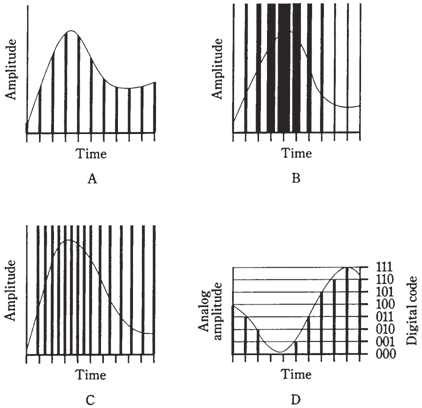Pulse modulation
The other method of modulation works by varying some aspect of the constant stream of signal pulses. Several types of pulse modulation (PM) are described below. They are diagrammed in the figure given below as amplitude versus time graphs. The modulating waveforms are shown by the curvy lines, and pulses as vertical lines.

Figure--Pulse modulation. At point A, pulse amplitude modulation; at point B, pulse width modulation; at point C, pulse interval modulation; and at D, pulse code modulation.
Pulse amplitude modulation
In the pulse amplitude modulation (PAM), strength of each individual pulse varies according to modulating waveform. PAM is very much like an ordinary amplitude modulation. An amplitude versus time graph of the hypothetical PAM signal is shown in the figure given below.Generally, the pulse amplitude increases as the instantaneous modulating-signal level increases. But this can be reversed, such that higher audio levels cause pulse amplitude to go down. Then the signal pulses are at their strongest when there is no modulation.Either the positive or negative PAM methods provide good results. The transmitter works a bit harder if negative modulation method is taken in used.
Pulse duration modulation
In PAM, all the pulses last for the same length of time. The effective transmitted power can be varied by changing actual peak amplitude of pulses. Another way to change transmitter output is to vary duration, or width, of pulses. This scheme is known as pulse duration modulation (PDM) or pulse width modulation (PWM), shown in the figure given below.Generally, the pulse duration increases as instantaneous modulating-signal level increases. But, as with the PAM, this can be reversed easily. The transmitter should work harder to accomplish the negative PDM. Regardless of positive or negative PDM is employed; peak pulse amplitude remains constant.
Pulse interval modulation
If all the pulses have same amplitude and same duration, modulation can still be accomplished by varying how often they happen. In PAM and PDM, pulses are always sent at same time interval, like 0.0001 second. But in the pulse interval modulation (PIM), also called as pulse frequency modulation (PFM), pulses may occur more or less frequently than zero-modulation interval. This is shown in the figure given below. Every pulse has same amplitude and same duration; it is their frequency which changes.When there is no modulation, pulses are evenly spaced with respect to the time. An increase in instantaneous data amplitude may cause pulses to be sent often, as is the case in the figure given below. Or, an increase in instantaneous data level might slow down rate at which pulses are sent. Both the scheme will work equally well.
Pulse code modulation
In the recent years, transmission of data has been done more by digital means. In digital communications, modulating data attains certain defined states, instead of continuously varying in an analog way. Digital transmission provides better efficiency than the analog transmission.With the digital modes, signal-to-noise ratio is better, bandwidth is narrower, and there are fewer errors. Teleprinter data is sent digitally, as is Morse code. But voices and video can also be sent digitally, too. The only drawback which the early digital experimenters faced was degraded fidelity. But today, that has been overcome to an extent which digitized music recordings and transmissions actually sound better than best analog reproductions.
In the pulse-code modulation (PCM), any of above aspects—amplitude, duration, or frequency—of the pulse train is varied. But instead of having infinitely many possible states, there are finitely many. The greater number of states, better the fidelity. But the transmitting and receiving equipment should be more sophisticated as the number of the digital states increases. An instance of 8-level PAM/PCM is shown in the given figure.